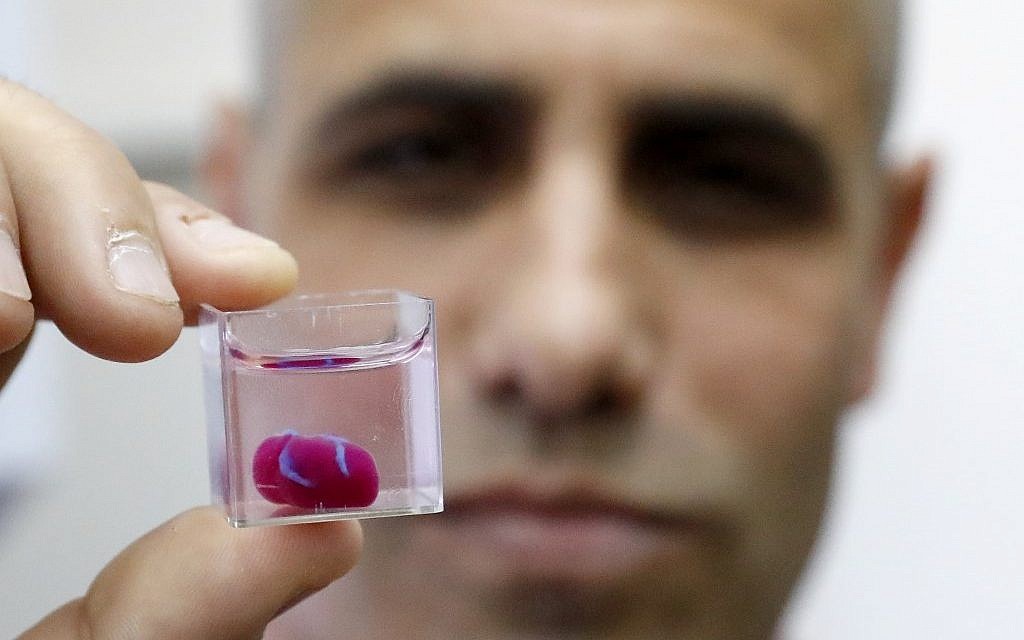Researchers have certainly been able to make huge strides over the decades, living and working in the 2D paradigm—along with relying on testing and experimenting using basic devices like the petri dish; however, the ability to engineer and 3D print (or bioprint) tissue has expanded resources for scientists exponentially. Now, Tel Aviv University (TAU), via its technology transfer company Ramot, with Bayer Pharmaceuticals to test drugs on 3D-printed heart tissue.
While there is a long list of the advantages in bioprinting, the ability to cut out experimenting on lab animals is definitely a change for the better too.
“In a petri dish, all the cells line up in 2D, and it’s only one type of cell” said Prof. Tal Dvir of TAU, the scientist responsible for developing the world’s first working 3D printed heart. “In contrast, our engineered tissues are 3D printed, and therefore better resemble real heart tissues,” she added.
The agreement between Bayer and TAU states that their collaboration will involve the development and testing of an in vitro cardiotoxicity platform in Dvir’s Laboratory for Tissue Engineering and Regenerative Medicine. This takes drug testing to a new level—and true reality with tissue engineering.

A 3D-printed, small-scaled human heart engineered from the patient’s own materials and cells. (Photo credit: Tel Aviv University)
“Our printed tissues contain cardiac muscle, blood vessels and the extracellular matrix which connects the different cells biochemically, mechanically and electrically. Moving away from petri dishes to 3D printed tissues could significantly improve drug tests, saving precious time and money with the hope of producing safer and more effective medication,” said Dvir.
“Our end goal is to engineer whole human hearts, including all the different chambers, valves, arteries and veins – the best analogue of this complex organ – for an even better toxicological screening process.”
This new research is, in fact, an extension of previous work using 3D-printed cardiac patches to regenerate hearts in patients suffering from cardiovascular disease. The patches served as a prime example of the potential for patient-specific treatment as the patches were made with fatty tissue removed from the patients themselves.
During the research project, they were also able to 3D print “comprehensive structures,” including an entire heart. Other scientists around the world have produced studies regarding bioprinted heart tissue, novel bioinks, and the development of scaffold-free cardiac constructs.
As researchers expect to be 3D printing patient-specific human organs in the next decade or so, medicine will be transformed as patients no longer have to worry about waiting lists—and dying during that extensive time—or issues with transplant rejection.
Ramot has also recently licensed their technology to Matricelf, a spin-off fabricating patient-specific spinal-cord implants.
[Source / Images: The Jerusalem Post]Subscribe to Our Email Newsletter
Stay up-to-date on all the latest news from the 3D printing industry and receive information and offers from third party vendors.
You May Also Like
Printing Money Episode 18: The DC Fly-In with Mark Burnham, AddMfgCoalition
It’s only been a week since the previous show, but Printing Money is back already with Episode 18. Certain events call for Printing Money’s coverage, and the recent 2nd Annual...
3DPOD Episode 199: Collaborative Design with Graham Bredemeyer, CEO of CADchat
About a decade ago, entrepreneur Graham Bredemeyer started Collider, a company that combined the best of 3D printing with injection molding. Now he runs CADChat, which hopes to make sharing...
Printing Money Episode 17: Recent 3D Printing Deals, with Alex Kingsbury
Printing Money is back with Episode 17! Our host, NewCap Partners‘ Danny Piper, is joined by Alex Kingsbury for this episode, so you can prepare yourself for smart coverage laced...
3DPOD Episode 198: High Speed Sintering with Neil Hopkinson, VP of AM at Stratasys
Neil Hopkinson, a pioneering 3D printing researcher, played a pivotal role in developing a body of research that is widely utilized today. He also invented High Speed Sintering (HSS), also...

































